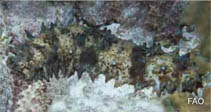| Diagnosis: |
Mean live weight 200 to 2500 g; body-wall thickness 0.2-0.8 cm. Body firm, rigid, square-ish in cross-section, flattened ventrally (trivium); body wall easily disintegrates outside sea water. Bivium covered with irregular warts, arranged in 8-10 longitudinal rows, with smaller papillae in between; warts larger near mouth. Trivium with yellow to pink podia delimited by a characteristic double row of large papillae 4 to 5 mm; stout podia arranged in 4 rows, on 3 radial bands, their disc about 380 micrometer in diameter. Mouth ventral, surrounded by a half row of papillae and 18 brown, short tentacles. Anus terminal. Calcareous ring with deeply indented radial pieces and triangular interradials. Cuvierian tubules absent. Bivium whitish to grey, with brown irregular dots; trivium lighter. Spicules with very characteristic rosettes, X-shaped, or elongate, numerous in the tegument; presence of numerous C-shaped spicules of 3 sizes; ventral tegument with tables of 2 sizes; some tables have a circular disc with 4 central and about 15 peripheral holes, bearing a spire with 4 pillars ending in a moderately spiny and cross-shaped crown; tables with a larger disc also present, more perforated, with a higher, spiny crown; only the first kind table found in the dorsal tegument; tables in papillae provided with a very large multiperforated disc, with a long, conical, smooth spire, ending in a single point; ventral papillae containing long, smooth rods; ventral podia have long rods, with central apophasis, and large elongate, multiperforated plates; tentacles with large rods, narrow, either curved with few spines, or straight and very spiny; X-, S-, and C-shaped small spicules. |

